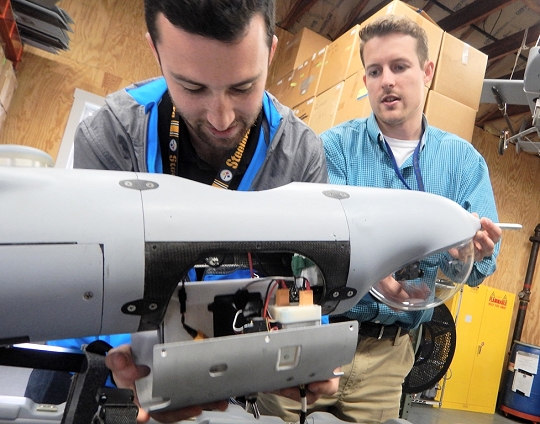 Navy scientist Jordan Lieberman, left, works with engineer Jonathan Crook to install the SCAPEGOAT payload onto a Boeing Insitu Scan Eagle unmanned aerial vehicle (UAV) prior to a system test flight. The SCAPEGOAT system - which includes modular interfaces to multiple chemical, biological, and radiological sensors and UAV platforms - was developed by junior scientists and engineers engaged in the Naval Surface Warfare Center Dahlgren Division sponsored Sly Fox Program over a six-month period.
Navy scientist Jordan Lieberman, left, works with engineer Jonathan Crook to install the SCAPEGOAT payload onto a Boeing Insitu Scan Eagle unmanned aerial vehicle (UAV) prior to a system test flight. The SCAPEGOAT system - which includes modular interfaces to multiple chemical, biological, and radiological sensors and UAV platforms - was developed by junior scientists and engineers engaged in the Naval Surface Warfare Center Dahlgren Division sponsored Sly Fox Program over a six-month period.DAHLGREN, Va. (June 22, 2017)—Sly Fox Mission 21 has all the trappings of a smash hit reality television series with a technological innovation that may one day save lives of warfighters across the joint services.
Although it was never filmed or broadcast, the drama, technology, and names of the seven junior scientists and engineers are real.
Hundreds of Navy civilian and military personnel witnessed this reality as the mission culminated with a technological capability demonstration on the Potomac River Test Range, June 15.
"One of the secrets to the Sly Fox Program's success is the makeup of the team—using scientists and engineers with fresh perspectives from a wide array of technical disciplines helps identify solutions that otherwise may not be apparent," said Kevin Cogley, head of the Naval Surface Warfare Center Dahlgren Division (NSWCDD) Chemical, Biological, and Radiological (CBR) Detection Branch.
Similar to reality TV, the Sly Fox members took time to get to know each other, including their strengths and weaknesses, as they worked to make the warfighter urgent need for an early warning CBR detection capability—adaptable to various unmanned aerial vehicles (UAVs)—a reality.
"The Sly Fox program serves as an outstanding experience accelerator for members our workforce," said Dale Sisson, NSWCDD deputy technical director. "By presenting the Sly Fox teams with real world challenges and schedules, we are able to allow them to gain valuable experience into what it takes to support our warfighters."
The team of mentors—senior NSWCDD scientists and engineers—ensured a strong focus on technical rigor as they taught the Sly Fox team how to perform under pressure.
"The program is challenging, both to the home organization and to the employee," said Mary Collings, head of the NSWCDD Gun Prototyping and Rapid Fielding Branch and supervisor of one of the Mission 21 team members. "It enables employees to experience the development of a system from beginning to end. They start with requirements and finish by demonstrating a product."
The intensive collaboration resulted in a system called SCAPEGOAT, otherwise known as 'Senses CBR Agents Pre-Engagement and Goes Over All Terrain'. The modular CBR detection system accommodates multiple sensor modules across multiple UAV platforms, enabling Sailors to better protect themselves from the increasing frequency of CBR attacks by relaying threat data to command and control assets.
Throughout the demonstration, spectators looked at the horizon over the Potomac River and viewed monitors to see the SCAPEGOAT system onboard a commercial octocopter UAS platform detect and report the presence of chemical simulants.
"It directly addresses a real warfighter need for low cost, flexible CBR early warning technologies," said Cogley, a Sly Fox process mentor. "While other organizations and industry have demonstrated similar capabilities, the SCAPEGOAT's low cost and ability to operate with multiple UAV platforms and CBR sensors is the unique quality that sets it apart from other solutions."
Early in the design phase, the team decided to integrate existing CBR detection technology into SCAPEGOAT, avoiding major modifications of CBR sensors and UAS platforms that involve strict payload weight limitations. Their decision led to a system design with three interchangeable mission modules—one each for the chemical detection, biological, and radiological detection capabilities.
Moreover, the chemical and radiological detection modules are compatible with currently fielded military sensors. The biological collection unit is a custom NSWCDD-designed module compatible with currently fielded filter media that uses a 12-volt fan to pull air through the system. In addition to CBR detection systems, SCAPEGOAT features modules for communications, a global positioning system, camera, and power.
As the demonstration concluded, team members reflected on their Sly Fox Mission experience and shared lessons learned.
"The primary lesson I learned from Sly Fox is the necessity of technical rigor in concept development, design, and testing," said Joshua Taylor, NSWCDD physicist. "Sly Fox connected me to people and resources around NSWCDD that left me with a deep appreciation of the scope and rigor of the work being done at Dahlgren. Subject matter experts that advised the development of the SCAPEGOAT inspired me to pursue a collaborative environment that is driven by real and present needs of the fleet, where I can be challenged to develop new skills."
"To actually experience the full development of a program in such a short timeframe, from defining requirements to testing and evaluation, has been enormously enlightening," said Charles Miller, NSWCDD scientist. "I learned a lot about the DoD acquisitions and rapid prototyping processes. This entailed striking a balance between the well-defined procurement process and the need for maximum flexibility in rapid prototyping."
"This Sly Fox team was one of the best teams I have ever worked on, and as an ensemble musician throughout most of my life, I've worked in group settings quite often," said Jordan Lieberman, NSWCDD physicist. "I've gained valuable experience in presenting and answering tough technical questions, skills that will be useful for the remainder of my career. The hardest part of this mission was developing requirements, concepts, and early designs for a product in a scientific field I had no previous experience in. I relied heavily on the knowledge and expertise of our mentors and on the members of the team with relevant experience."
The benefit of transitioning technical, project management and leadership knowledge to junior engineers and scientists across organizations is reflected in the careers of Sly Fox Mission members since the first Sly Fox Mission was launched in 2002. The inaugural team successfully developed the Passive Anti-Ship Missile Detection System within the designated six-month timeframe and confirmed the Sly Fox program was an excellent way to develop leadership skills for young engineers and scientists.
"Each and every one of the outcomes from the Sly Fox teams is nothing short of impressive," said Sisson. "The Mission 21 team is certainly no exception. Having had the opportunity to see them in action, I was extremely impressed with the level of professionalism with which the team conducted their mission and excited to see the technical prowess that they collectively demonstrated. I am a huge fan of the Sly Fox Program and feel that the Sly Fox missions are absolutely critical to our workforce development efforts."
DoD and government officials attending the demonstration represented commands and agencies that included the Chemical Biological Incident Response Force, Joint Program Executive Office for Chemical and Biological Defense, Marine Corps Systems Command, Marine Corps Forces Command, Office of the Assistant Secretary of Defense for Nuclear, Chemical, and Biological Defense Programs, Defense Threat Reduction Agency, Naval Research Laboratory, Pentagon Force Protection Agency, U.S. Coast Guard, Naval Sea Systems Command, and the Office of the Chief of Naval Operations.
The Sly Fox program is an NSWCDD Naval Innovative Science and Engineering (section 219) funded rapid prototyping program intended to develop the science and engineering workforce while applying their talents to known technology gaps. Like the previous 20 missions—including efforts in directed energy, radar systems, unmanned systems, and cyber threats—Sly Fox Mission 21 took advantage of the diverse skills of its team members to tackle a mission that is important to NSWCDD and its customers.
As the mission concludes on June 30, team members will depart with new technical experiences, unique perspectives on rapid development, and a network of professional colleagues from across the command that will guide them in their current positions and throughout their careers.



